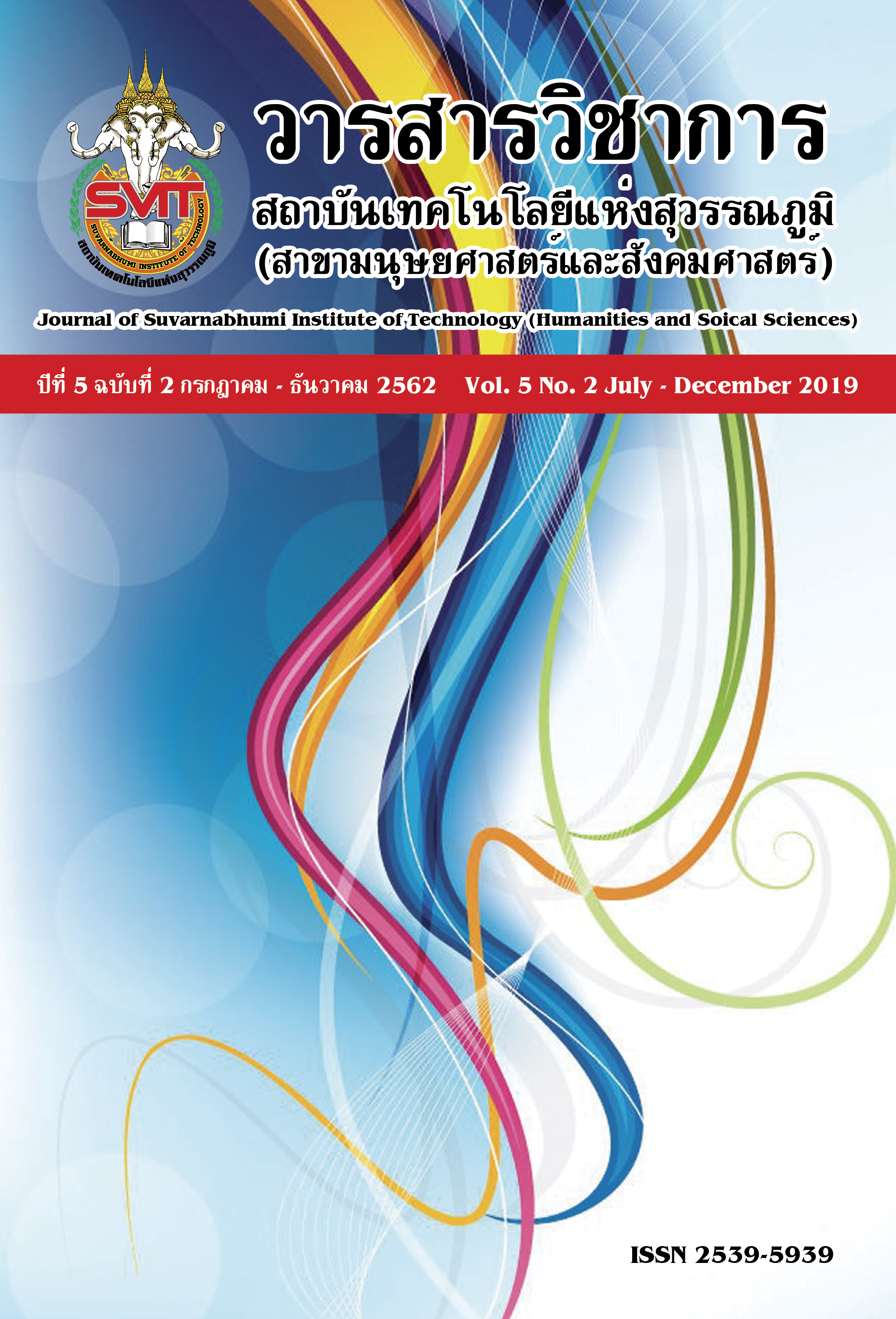THE DEVELOPMENT OF ASSESSMENT ON TEACHERS’ TEACHING COMPETENCY IN PRIMARY SCHOOLS UNDER THE JURISDICTION OF OFFICE OF THE BASIC EDUCATION COMMISSION IN THE EASTERN REGION
Keywords:
Developing the assessment competency modlesAbstract
This research objectives were : 1) to study the condition and problems of the assessment on the teacher’s teaching competency in primary schools under the Jurisdiction of Office of the Basic Education Commission in the Eastern Region, 2) to create and develop of the assessment competency models on teacher’s teaching in primary schools, under the Jurisdiction of Office of the Basic Education Commission in the Eastern Region, 3) to assess the assessment competency models on teacher’s teaching in the primary schools under the Jurisdiction of Office of the Basic Education Commission in the Eastern Region. There were 3 steps to process the research as follows: Step 1. To study and assess on teacher’s teaching competency in primary schools by interviewing. The primary schools directors and the expert teachers who taught at the primary school level. Step 2. Creating and developing the assessment models on teacher’s teaching in primary schools, using factor analysis. Data was collected from the sample group of 112 people by the specific identification method. The sample group consisted of the primary schools directors and the expert teacher’s of 42 people and the 70 expert on teacher’s teaching in primary schools. Confirmatory factor analysis was done with LISRIEL, the results were used to create the questionnaires, the content validity was checked by experts. The consistency of the model was checked with empirical data. And the manual model to assess the teacher’s teaching performance. Step 3. Assessing the models on competency on teacher’s teaching in the primary schools by the experimental method.
The results of study 1) the condition and problems of the assessment on the teacher teaching competency. It was found that they were the assessment on the teacher’s teachings competency occurred 1-2 times per year, but there were the overall of the management assessment. Incompletion of documents, lacking of the instruments and there were unable to models. Teachers lacked of modern innovative media. There were unable to manage integrated teaching. They lacked systemic management and did not cover in every issue. 2) Creating and developing the assessment models on competency. The teaching competency models were consistent with empirical data (x2 = 193.63 , p = , df = 105 , GFI = 0.946, AGFI = 0.912 , R MSEA = 0.047X). 3) The results of creating the assessment manual models of the assessment competencies on teacher’s teaching found that the appropriate data analysis were in accordance with the specified criteria. That from 80 percent to 100 percent.
The assessment on teacher’s teaching competency found that they were 5 elements. 1) Focusing on the achievement operational of performance. 2) Good management. 3) Self-development. One element assessment could affect other elements. Therefore, all elements of the operation could be developed in order to further develop on the teacher’s teachings.
References
ชัชรินทร์ ชวนวัน. (2554). Competency กับการนำไปใช้พัฒนาบุคคล. ค้นเมื่อ 23 มีนาคม 2555, จาก http//www.nidtep.go.th/files/100956-21.pdf
ดนัย เทียนพุฒ. (2550). ความสามารถในทรรศนะ ดร.ดนัย เทียนพุฒ.กรุงเทพฯ : บริษัท เอ.อาร์.อินเฟอร์เมชั่น แอน พับลิเคชั่น จำกัด.
ทิศนา แขมมณี. (2530). การทดลองใช้รูปแบบการฝึกทักษะการทำงานกลุ่ม สำหรับนักเรียนระดับประถมศึกษา. กรุงเทพฯ: สำนักพิมพ์ แห่งจุฬาลงกรณ์มหาวิทยาลัย
ธำรงศักดิ์ คงคาสวัสดิ์. (2549). Competency ภาคปฏิบัติเขาทำกันอย่างไร?. กรุงเทพฯ : สำนักพิมพ์ สมาคมส่งเสริมเทคโนโลยี (ไทย-ญี่ปุ่น).
นงลักษณ์ วิรัชชัย. (2541). เอกสารประกอบการาสอนวิชาสถิติการศึกษาและแนวโน้ม. กรุงเทพ: จุฬาลงกรณ์มหาวิทยาลัย, คณะครุศาสตร์, ภาควิชาวิจัยการศึกษา.
นิสดารก์ เวชยานนท์.(2553).Competency-Based Approach.พิมพ์ครั้งที่ 4 กรุงเทพฯ: บริษัท เดอะกราฟิโก ซิสเต็มส์ จำกัด.
นครชัย ชาญอุไร.(2551).สมรรถนะคืออะไร.บทความสาขาวิจัยและการประเมินผลการศึกษา คณะศึกษาศาสตร์.มหาวิทยาลัยมหาสารคาม.
บุญชม ศรีสะอาด. (2533). การพัฒนาการวิจัยโดยใช้รูปแบบ. วารสารการวิจัยทางการศึกษา, 20(2), 1-6
ปฐมพงศ์ ศุภเลิศ.(2551). สมรรถนะของผู้ประกอบวิชาชีพทางการ.เข้าถึงเมื่อ 4 กุมภาพันธ์ 2551.
ประพันธ์ คำมูล.(2543).”ครูมืออาชีพ,” วิชาการ. (12 ธันวาคม 2543):13
เยาวดี (รางชัยกุล) วิบูลย์ศรี.(2542).การประเมินโครงการ.กรุงเทพฯ:สำนักพิมพ์จุฬาลงกรณ์มหาวิทยาลัย.
รัศมี สีหะนันท์. (2551). วิจัยและประเมินผลการศึกษา.มหาวิทยาลัยราชภัฏอุบลราชธานี.
วนิดา ภูวนารถนุรักษ์.(2552) “สมรรถนะครูไทย” วารสารคำแหง 26,ฉบับพิเศษ (ตุลาคม-ธันวาคม):69-79
ศิริชัย กาญจนวาสี. (2550). ทฤษฎีการประเมิน. พิมพ์ครั้งที่ 5. กรุงเทพฯ: สำนักพิมพ์-แห่งจุฬาลงกรณ์มหาวิทยาลัย.
ศิริชัย กาญจนวาสี. (2545). ทฤษฎีการประเมิน. (พิมพ์ครั้งที่ 2). กรุงเทพฯ: สำนักพิมพ์แห่งจุฬาลงกรณ์มหาวิทยาลัย.
สำนักงานคณะกรรมการการศึกษาขั้นพื้นฐาน. (2545). พระราชบัญญัติการศึกษาแห่งชาติ พ.ศ. 2542 และที่แก้ไขเพิ่มเติม (ฉบับที่ 2) พ.ศ. 2545. กรุงเทพฯ: โรงพิมพ์-พริกหวานกราฟฟิค.
สำนักงานคณะกรรมการข้าราชการพลเรือน. (2548). การปรับใช้สมรรถนะในการบริหารทรัพยากรมนุษย์.ค้นเมื่อ 14 ธันวาคม 2552, จาก http://ocsc.go.th/veform/ PDF/Competency.pdf
สำนักงานเลขาธิการคุรสภา, สำนักมาตรฐานวิชาชีพ.(2548). มาตรฐานวิชาชีพทางการศึกษา. กรุงเทพฯ : สำนักงานเลขาธิการคุรสภา.
สุกัญญา รัศมีธรรมโชติ. (2547). Competency: เครื่องมือการบริหารที่ปฏิเสธไม่ได้.วารสาร Productivity World, 9 (53), 17-79.
สุกัญญา รัศมีธรรมโชติ. (2547). แนวทางการพัฒนาศักยภาพมนุษย์ด้วย Competency-Based learning. กรุงเทพฯ: สถาบันเพิ่มผลผลิตแห่งชาติ.
สุกัญญา รัศมีธรรมโชติ. (2551).การจัดการทรัพยากรมนุษย์ด้วย Competency Based HRM.พิมพ์ครั้งที่ 2. กรุงเทพฯ : บริษัท ซีเอ็ดยูเคชั่น จำกัด (มหาชน).
สุรชัย พรหมพันธ์.(2554).องค์ประกอบของสมรรถนะ.กรุงเทพฯ : ปัญญาชน.
Bloom, B. S. (1976). Human characteristics and school learning . New York: McGraw-Hill.
Boyatzis, R. E. (1982). The competent manager: A model for effective Performance. New York: John Wiley & Sons.
Dubois,David D.and other.(2004).Competency-Based Human Resource Management. The United State of America:Davies-Black Publishing,a division of CPP,Inc.
Klendauer, R., Berkovich, M., Gelvin, R., Leimeister, J. M., & Krcmar, H.(2012).Towards a Competency model for requirements analysis. Information Systems Journal , 22, 475-503.
Mc Lagan, P . (1997). Competencies: The next generation. Training and Development, 51(5), 40-47.
McClelland, D. C. (1973). “Testing for competence rather than for intelligence”. American Psychologist, 28, 1-14.
O’Hagan, K. (1996). Competence in social work practice: A practical, guide for professional. London: Prentice-Hall.
Parry, S. B. (1996). “The quest for competencies”. Training, 33(7), 48-54.
Parsons,J.K.(2004). Organization and management in school perspectives for practicing teacher and governors.2nded.London: Longman.
Shermon, G. (2004). Competencies base HRM: A strategic resource for Competencies mapping. New Delhi, India: McGraw-Hill.
Spencer, M. L., & Spencer, M. S. (1993). Competency at work: Models for Superior performance. New York: John Wiley & Son.
Western Australia Government, Department of Educational and Training. (2004). Teacher competency framework. Retrieved December 20, 2006, from http:www.det.wa.gov.au/_education/cps/doer/teacher_Competency_framwork/pdf
Worthen, B. R., & Sander, J. R. (1973). Eduation evaluation: Theory and Practice. Worthington, OH: Charles J. Jones.
Downloads
Published
Issue
Section
License
บทความที่ได้รับการตีพิมพ์เป็นลิขสิทธิ์ของวารสารวิชาการ สถาบันเทคโนโลยีแห่งสุวรรณภูมิ
ข้อความที่ปรากฏในบทความแต่ละเรื่องในวารสารวิชาการเล่มนี้เป็นความคิดเห็นส่วนตัวของผู้เขียนแต่ละท่านไม่เกี่ยวข้องกับสถาบันเทคโนโลยีแห่งสุวรรณภูมิ และคณาจารย์ท่านอื่นๆในสถาบันฯ แต่อย่างใด ความรับผิดชอบองค์ประกอบทั้งหมดของบทความแต่ละเรื่องเป็นของผู้เขียนแต่ละท่าน หากมีความผิดพลาดใดๆ ผู้เขียนแต่ละท่านจะรับผิดชอบบทความของตนเองแต่ผู้เดียว





